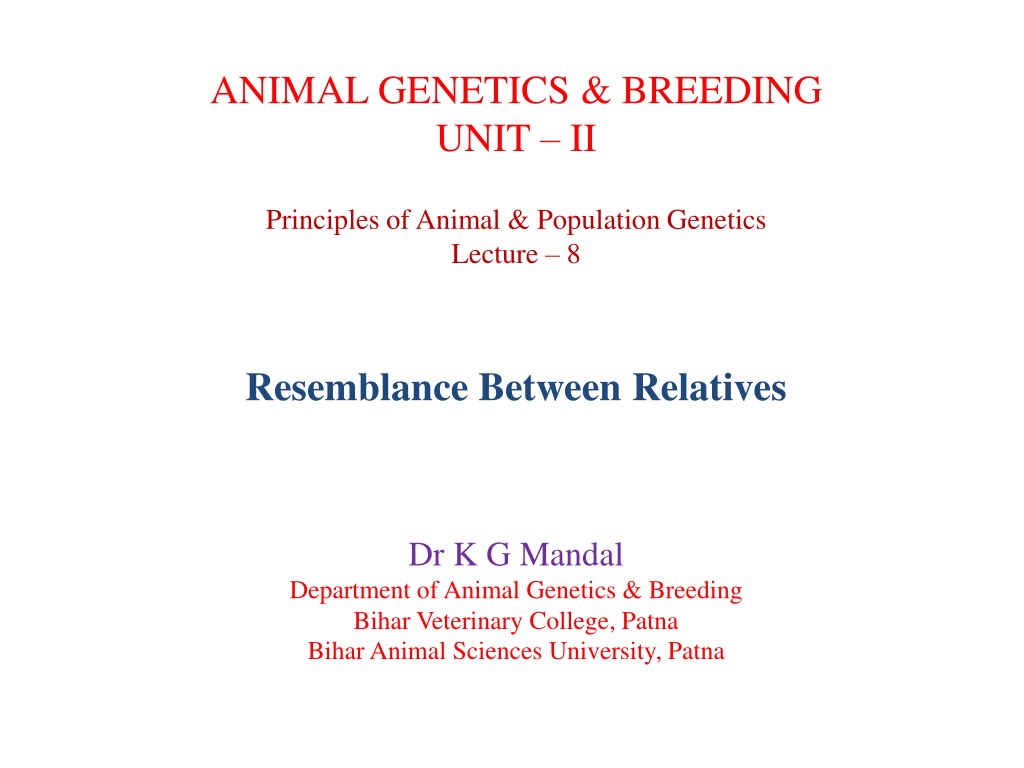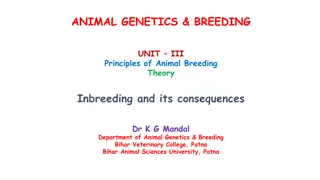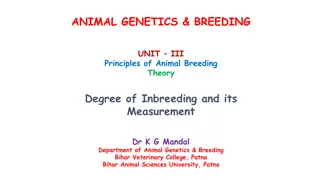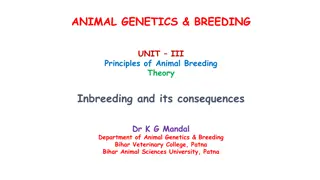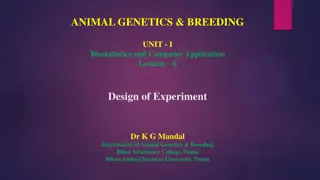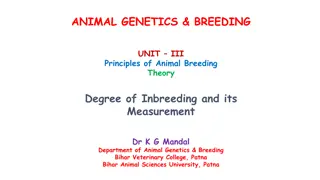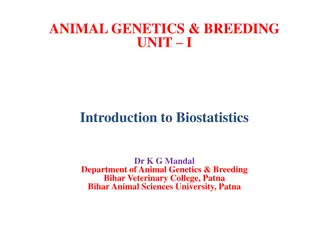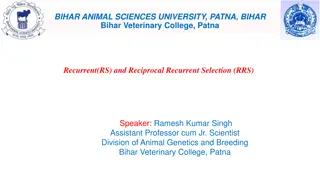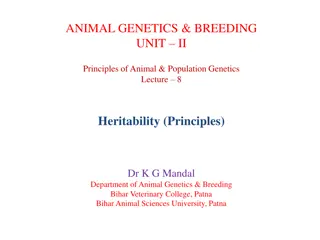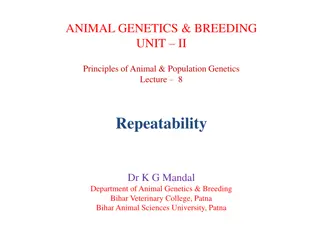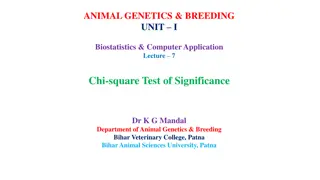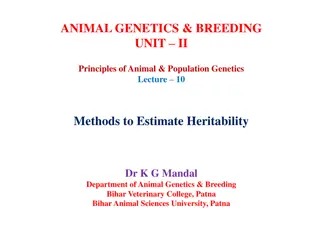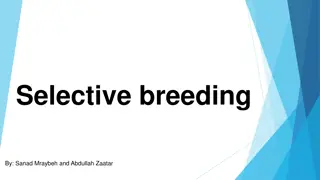Understanding Resemblance Between Relatives in Animal Genetics & Breeding
Explore the concept of resemblance between relatives in animal genetics, including direct and collateral relatives who share common genes. Learn how genetic similarities manifest in related individuals and the significance of measuring degrees of resemblance for estimating genetic variance and heritability.
Download Presentation

Please find below an Image/Link to download the presentation.
The content on the website is provided AS IS for your information and personal use only. It may not be sold, licensed, or shared on other websites without obtaining consent from the author. Download presentation by click this link. If you encounter any issues during the download, it is possible that the publisher has removed the file from their server.
E N D
Presentation Transcript
ANIMAL GENETICS & BREEDING UNIT II Principles of Animal & Population Genetics Lecture 8 Resemblance Between Relatives Dr K G Mandal Department of Animal Genetics & Breeding Bihar Veterinary College, Patna Bihar Animal Sciences University, Patna
Resemblance Between Relatives Who are the relatives? In terms of genetics, those who share some genes in common due to common ancestry. Example: Direct relatives Parent offspring Grand Parent grand son Collateral relatives Half-sibs Full-sibs Cousin brother - sister
Resemblance? It means look alike or similarity. Hence, resemblance between relatives means similarity individuals. Related individuals look alike because they share common genes & environment. More common genes they have and share more common environment, they will be more resemble to each other. between related common
Different sort of relatives will show different degrees of resemblance more closely relatives will show more resemblance. Resemblance between relatives is the property of metric characters.
Objectives Helps in grouping of relatives according to their family. Helps in partitioning component of variance. The degree of resemblance provides the methods of estimating the amount of additive genetic variance (VA). Provides the methods heritability. observational to estimate
Measurement of degree of resemblance between relatives rests on partitioning the observed phenotypic variance into components corresponding grouping of individuals into family of half-sibs, full-sibs and parent-offspring. to the
Types of variance: Causal components of variance V Example : VP = VG + VE = VA + VD + VI + VE Observational components of variance 2 2P = 2G + 2E = 2A + 2D + 2I + 2E The observed components of variance can be estimated directly from observed phenotypic values and for this reason they are called as observational components of variance.
Relatives are correlated to each other due to presence of common genes. The amount of correlation depends on the degree of relationship. Correlation resemblance between relatives. between relatives is the Covariance is used to measure the correlation between relatives. The degree of resemblance between relatives is the amount of covariance measured as a proportion of the total phenotypic variance.
Measurement of Covariance Full-sibs: The partitioned into two components : between groups ( 2B) & within groups ( 2W) The degree of resemblance between full-sibs is termed as intra-class correlation and denoted as t . t = 2B/ ( 2 B + 2 W) = CoV(FS)/ 2P (observed phenotypic Variance) observed phenotypic variance is
Parent - Offspring relationship: In case of parent-offspring relationship, the grouping of observation is made into pairs rather than groups. (i) One parent with one offspring (ii) One parent with mean of several offspring (iii) Mid-parent with one offspring (iv)Mid-parent with mean of several offspring The resemblance between parent-offspring is obtained through the estimation of covariance.
The degree of resemblance between parent- offspring is expressed as regression of offspring on parent, bop. bop = CovOP/ 2P Both genetic and environmental sources of variance contribute to the co-variances of relatives, the co-variances of phenotypic values being sum of the genetic and environmental co-variances.
Methods to estimate Genetic Covariance 1. Direct relatives: The co-variances of offspring with parent is computed from the sum of cross products, and the degree of resemblance is expressed as the regression of offspring on parent, thus bop = CovOP / 2P Where, 2P = variance of parent CovOP = covariance of offspring & parent
(i) Offspring and one parent: CovOP = Genotypic value of parent x Mean value of progeny = Genotypic value of parent x of its breeding value = G A = (A + D) A since, G = A + D = A2 + AD = VA + CovAD = VA since, CovAD = zero
The offspring and one parent is the regression of offspring on one parent, then bop = Cov OP / 2P = VA/VP degree of resemblance between (ii) Offspring and mid-parent: Covariance of the mean of offspring and mean of both the parents : Let o = the mean value of progeny, P1 & P2 = the values of two parents, P = (P1 + P2) = mid-parental value
Sum of cross product, OP = ( OP1 + OP2) CovOP = (CovOP1 + CovOP2) Assume that P1 & P2 have same variance, then, CovOP = (CovOP + CovOP) = x2CovOP = CovOP = VA
Though the covariance of both the parents are same but observed phenotypic variances are not the same. Let phenotypic values of P1 & P2 as M1 & M2 respectively. Then, P = (M1 + M2) P2 = [ (M1 + M2)]2 = (M12 +M22 + 2M1M2) 2P = ( 2M1 + 2M2 + 2CovM1M2) = ( 2M1 + 2M2)
Assume that variance of both the parents are equal. Then, 2P = x2 2M = 2M = VP The degree of resemblance between offspring and mid-parent, bop = CovOP/ 2P = VA/ VP = VA/VP
2. Collateral Relatives: In case of collateral relatives (HS and FS), the total observed phenotypic variance ( 2P) is partitioned into between group component of variance ( 2B) and within group component of variance ( 2W). That is, 2P = 2B + 2W 2B covariance between groups 2w = variance of individuals within the group
(i) Degree of resemblance between HS: HS groups constitute the sire family, since sire becomes the common parent. Cov(HS) = variance of half of the BV of common parent. Cov(HS) = ( A)2 = A2 = 2A Thus, Cov(HS) = 2S = 2A
Degree of resemblance between HS, t = 2B/( 2B + 2W) = 2S/( 2S + 2W) = Cov(HS)/ 2P = VA/VP
(ii) Degreeof resemblance between FS: In FS, both parents are common. Mean genotypic value of FS = mean BV of both the parents. Let A & A be the BV of parents respectively. Then, covariance of BV is the variance of (A + A ) = [ (A + A )]2 = (A2 + A 2 + 2CoVAA ) = (VA + VA ) = (VA + VA) = x2VA = VA
Variance of dominance deviation of two parents is = VD Genetic Covariance of FS, Cov(FS) = VA + VD Degree of resemblance between FS is the correlation between FS, i.e., Cov(FS)/VP t = ( VA + VD)/VP Cov(FS) 2Cov(HS) = VA + VD 2( VA) = VA + VD - VA = VD
Phenotypic resemblance between relatives Relatives Covariance Degree of resemblance Cov OP / 2P Regression (b) Or correlation (r) bop = VA/VP Offspring & one parent Cov OP = VA bop = VA/VP CovOP = VA CovOP/ 2P Offspring & mid-parent t = VA/VP t = ( VA + VD)/ VP Cov(HS) = VA Cov(FS) = VA + VD Cov(HS)/ 2P Cov(FS)/VP Half sibs Full sibs
